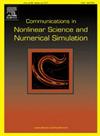Three implementations of B-differentiable Newton method in solving 3D elastoplastic frictional contact problems and their discussion
IF 3.4
2区 数学
Q1 MATHEMATICS, APPLIED
Communications in Nonlinear Science and Numerical Simulation
Pub Date : 2025-04-22
DOI:10.1016/j.cnsns.2025.108888
引用次数: 0
Abstract
In this paper, three implementations of B-differentiable Newton method (BDNM) for solving 3D elastoplastic frictional contact problems are presented. In the first two methods, a nested strategy is employed. The contact equations, which are solely associated with the contact conditions in the normal and tangential directions due to the introduction of the contact flexibility matrix, are expressed as B-differentiable equations. They are solved in the external iteration, or regarded as a sub-step nested within the solution of nonlinear equilibrium equations, leading to the decoupling of the calculations for nonlinear equilibrium equations and contact forces. In the third method, both the nonlinear equilibrium equations and contact conditions are expressed as B-differentiable equations simultaneously. Both nodal displacement and contact force are treated as independent variables, solved using BDNM to ensure the global convergence, with a variant of a Jacobian matrix associated with unknowns derived. In the numerical examples, the accuracy of the proposed methods is demonstrated by comparing with the results obtained from ANSYS. The convergence and computational efficiency are investigated through a series of models with varying degrees of freedom (DOFs) and contact node pairs (CNPs). The robustness of the proposed methods is presented by applying them to the analysis of an arch dam with seven transverse joints.
b -可微牛顿法求解三维弹塑性摩擦接触问题的三种实现及其讨论
本文给出了求解三维弹塑性摩擦接触问题的b -可微牛顿法的三种实现方法。在前两种方法中,采用了嵌套策略。由于接触柔度矩阵的引入,接触方程仅与法向和切向的接触条件相关联,并表示为b可微方程。它们在外部迭代中求解,或作为嵌套在非线性平衡方程解中的子步骤,导致非线性平衡方程和接触力的计算解耦。在第三种方法中,将非线性平衡方程和接触条件同时表示为b可微方程。将节点位移和接触力作为自变量处理,采用BDNM求解以保证全局收敛,并推导出与未知量相关的雅可比矩阵的变量。数值算例中,通过与ANSYS计算结果的比较,验证了所提方法的准确性。通过一系列不同自由度(DOFs)和接触节点对(CNPs)的模型,研究了该方法的收敛性和计算效率。通过对具有7个横向缝的拱坝进行分析,证明了所提方法的鲁棒性。
本文章由计算机程序翻译,如有差异,请以英文原文为准。
求助全文
约1分钟内获得全文
求助全文
来源期刊

Communications in Nonlinear Science and Numerical Simulation
MATHEMATICS, APPLIED-MATHEMATICS, INTERDISCIPLINARY APPLICATIONS
CiteScore
6.80
自引率
7.70%
发文量
378
审稿时长
78 days
期刊介绍:
The journal publishes original research findings on experimental observation, mathematical modeling, theoretical analysis and numerical simulation, for more accurate description, better prediction or novel application, of nonlinear phenomena in science and engineering. It offers a venue for researchers to make rapid exchange of ideas and techniques in nonlinear science and complexity.
The submission of manuscripts with cross-disciplinary approaches in nonlinear science and complexity is particularly encouraged.
Topics of interest:
Nonlinear differential or delay equations, Lie group analysis and asymptotic methods, Discontinuous systems, Fractals, Fractional calculus and dynamics, Nonlinear effects in quantum mechanics, Nonlinear stochastic processes, Experimental nonlinear science, Time-series and signal analysis, Computational methods and simulations in nonlinear science and engineering, Control of dynamical systems, Synchronization, Lyapunov analysis, High-dimensional chaos and turbulence, Chaos in Hamiltonian systems, Integrable systems and solitons, Collective behavior in many-body systems, Biological physics and networks, Nonlinear mechanical systems, Complex systems and complexity.
No length limitation for contributions is set, but only concisely written manuscripts are published. Brief papers are published on the basis of Rapid Communications. Discussions of previously published papers are welcome.
 求助内容:
求助内容: 应助结果提醒方式:
应助结果提醒方式:


